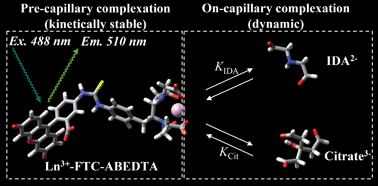The ultratrace level detection and the separation of lanthanide ions (Ln3+) were achieved using capillary zone electrophoresis with laser induced fluorescent detection (CZE-LIF) using an aromatic polyaminocarboxylate ligand synthesized in our previous work. The ligand forms kinetically stable Ln complexes at the pre-capillary derivatizing step. It effectively avoids quenching processes of the ligand-centered fluorescence through complexation with Ln3+ without paramagnetic and heavy atom effects because of the distance between the chelating and the antenna moieties. During the on-capillary separation step, the mother Ln complexes competitively form ternary complexes with the auxiliary ligands, iminodiacetate and citrate, which provide different mobilities for each of the Ln3+ complexes. The emissively labeled Ln3+ complexes were efficiently separated, based on the ternary complex equilibrium. Since the carrier buffer employed was free from emissive ligands, a high signal to noise ratio was obtained. A lower detection limit of 9.1 × 10−11 mol dm−3 (15.6 ng dm−3, 0.46 attomole as an amount basis) was successfully achieved typically for Lu3+ with a simple CZE mode. We propose a combination of a pre-capillary and an on-capillary complexing technique as a method that provides both high sensitivity and high resolution.

You have access to this article
 Please wait while we load your content...
Something went wrong. Try again?
Please wait while we load your content...
Something went wrong. Try again?


 Please wait while we load your content...
Please wait while we load your content...